Avery Bradley, 62, Shooting Guard, Freshman, Texas
11.6 points, 2.9 rebounds, 2.1 assists, 1.3 steals, 1.5 turnovers, 43% FG, 55% FT, 38% 3PT
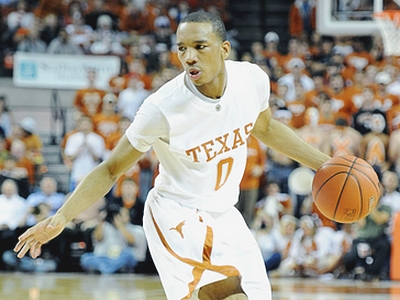
Joseph Treutlein
Avery Bradley has had an inconsistent freshman season, not unlike many of his teammates and the Texas Longhorns as a whole. Bradleys shots and production fluctuated wildly from game to game, and he didnt do much to improve on his weaknesses over the course of the season, though the one thing that remained consistent throughout was his intense, smothering defense. We covered Bradley extensively less than two months ago here, but with many indications suggesting hell be entering his name in the draft, its worth taking a more detailed look at this unconventional player whose stock is likely to be all over scouts boards.
Bradley is a somewhat unique prospect in that there really isnt anyone in the NBA with his skill set, and there are questions about how easily hell be able to find a niche. The majority of undersized pure 2s in the NBA are versatile scorers that can consistently create their own shot, while Bradley on the other hand is a more selective shooter who isnt adept at getting to the rim, though is also an outstanding defender.
Bradleys lack of anything resembling playmaking skills or a point guard mentality may be his most concerning attribute projecting to the pros, as itll be very tough to play him at the 1-spot without great shot-creators around him. While Bradley is capable of making flow-of-the-offense passes to open shooters at times, when he puts the ball on the floor he goes into clear scorer mode, looking exclusively for his own shot, even out of pick-and-roll scenarios. Developing into a more versatile pick-and-roll threat could vastly open up his own offense, while also giving teams another reason to give him playing time. This might be the most important thing to follow as the freshmans career progresses.
Bradleys strongest offensive attribute is undoubtedly his jump shot, which he is very reliable with in catch-and-shoot situations and pulling up off one or two quick, compact dribbles. While lacking much in the line of advanced moves, Bradley still does an excellent job getting separation for his jumper by using shot fakes, jab steps, and rip moves in combination with good footwork and a good first step. The interesting thing about Bradleys shot is that in spite of having very good form, boasting great elevation and a high and quick release, hes still prone to many shots that completely miss the mark, and hes shooting a surprisingly poor 55% from the free-throw line (albeit on a limited 66 attempts).
Speaking of free throws, another major problem area in Bradleys game is his inability to get to the line, something that most combo guards in todays NBA are expected to do. He ranks dead last in free throws attempted per-40 minutes pace adjusted amongst all players in our 2010 or 2011 mock drafts in fact, drawing just 66 attempts in 1000 minutes this season, or one for every 15 minutes hes on the floor.
Another issues revolves around his inability to get high efficiency possessions around the basket in general. Hes scoring an incredibly poor 0.75 points per shot on shots around the basket according to Synergy, and in watching his game, its easy to see why. Bradley is often out of control on his drives to the basket and very rarely puts in much effort to create high percentage looks, rather trying to get close to the rim and then just throwing the ball in the general direction of it. On the bright side, Bradley does show an effective floater when hes intently looking for it, and many of his problems attacking the basket are related to a careless mentality as opposed to lack of ability, though he will certainly have some limitations projecting to the pros given his lack of size and strength.
Defensively is where Bradley projects best to the pro level, but the problem here is he will need to find a proper niche to best put his strengths to use, as his physical makeup is much better suited to defending point guards and combo-guards than it is taller shooting guards. Bigger players will be able to simply shoot over him and overpower him on drives to the basket, things that happened when faced with those situations this yearfor example against James Anderson.
To Bradleys credit, one thing he does incredibly well is play outstanding prevent defense off the ball, sticking to his man like glue all over the floor and blocking off passing lanes to keep the ball away. On the ball, his lateral quickness is superb, as is his fundamental stance, and he puts in excellent effort all the time, getting right up into his man no matter where he is on the floor, using his length and hands very well, and always getting a hand up to contest a shot. For all of Bradleys strengths on defense, however, he has struggled defending the pick-and-roll this season, due in part to his physical nature, as hes prone to run full force into a well-set pick, getting stuck and not being able to recover, as he doesnt have the strength to fight through them.
Looking forward, Bradley is an extremely interesting prospect, but where and who he gets drafted by will have a huge impact on his immediate success in the league. Playing alongside a big shot creator (such as Tyreke Evans or Dwayne Wade) who can defend 2s, or coming off the bench to play off the ball and defend opposing point guards or combo guards are situations he could find himself excelling in.
He should also benefit from playing alongside more steady playmakers in the pros than the revolving door of shaky point guard play he saw at Texas. Continuing to work on his three-point range, being more focused on his shot attempts in the lane, and really working to develop his pick-and-roll game should be among his priorities, and all of those things could help him find more potential niches in the pros, something that could be challenging if he is drafted into a tough situation.
Avery Bradley has had an inconsistent freshman season, not unlike many of his teammates and the Texas Longhorns as a whole. Bradleys shots and production fluctuated wildly from game to game, and he didnt do much to improve on his weaknesses over the course of the season, though the one thing that remained consistent throughout was his intense, smothering defense. We covered Bradley extensively less than two months ago here, but with many indications suggesting hell be entering his name in the draft, its worth taking a more detailed look at this unconventional player whose stock is likely to be all over scouts boards.
Bradley is a somewhat unique prospect in that there really isnt anyone in the NBA with his skill set, and there are questions about how easily hell be able to find a niche. The majority of undersized pure 2s in the NBA are versatile scorers that can consistently create their own shot, while Bradley on the other hand is a more selective shooter who isnt adept at getting to the rim, though is also an outstanding defender.
Bradleys lack of anything resembling playmaking skills or a point guard mentality may be his most concerning attribute projecting to the pros, as itll be very tough to play him at the 1-spot without great shot-creators around him. While Bradley is capable of making flow-of-the-offense passes to open shooters at times, when he puts the ball on the floor he goes into clear scorer mode, looking exclusively for his own shot, even out of pick-and-roll scenarios. Developing into a more versatile pick-and-roll threat could vastly open up his own offense, while also giving teams another reason to give him playing time. This might be the most important thing to follow as the freshmans career progresses.
Bradleys strongest offensive attribute is undoubtedly his jump shot, which he is very reliable with in catch-and-shoot situations and pulling up off one or two quick, compact dribbles. While lacking much in the line of advanced moves, Bradley still does an excellent job getting separation for his jumper by using shot fakes, jab steps, and rip moves in combination with good footwork and a good first step. The interesting thing about Bradleys shot is that in spite of having very good form, boasting great elevation and a high and quick release, hes still prone to many shots that completely miss the mark, and hes shooting a surprisingly poor 55% from the free-throw line (albeit on a limited 66 attempts).
Speaking of free throws, another major problem area in Bradleys game is his inability to get to the line, something that most combo guards in todays NBA are expected to do. He ranks dead last in free throws attempted per-40 minutes pace adjusted amongst all players in our 2010 or 2011 mock drafts in fact, drawing just 66 attempts in 1000 minutes this season, or one for every 15 minutes hes on the floor.
Another issues revolves around his inability to get high efficiency possessions around the basket in general. Hes scoring an incredibly poor 0.75 points per shot on shots around the basket according to Synergy, and in watching his game, its easy to see why. Bradley is often out of control on his drives to the basket and very rarely puts in much effort to create high percentage looks, rather trying to get close to the rim and then just throwing the ball in the general direction of it. On the bright side, Bradley does show an effective floater when hes intently looking for it, and many of his problems attacking the basket are related to a careless mentality as opposed to lack of ability, though he will certainly have some limitations projecting to the pros given his lack of size and strength.
Defensively is where Bradley projects best to the pro level, but the problem here is he will need to find a proper niche to best put his strengths to use, as his physical makeup is much better suited to defending point guards and combo-guards than it is taller shooting guards. Bigger players will be able to simply shoot over him and overpower him on drives to the basket, things that happened when faced with those situations this yearfor example against James Anderson.
To Bradleys credit, one thing he does incredibly well is play outstanding prevent defense off the ball, sticking to his man like glue all over the floor and blocking off passing lanes to keep the ball away. On the ball, his lateral quickness is superb, as is his fundamental stance, and he puts in excellent effort all the time, getting right up into his man no matter where he is on the floor, using his length and hands very well, and always getting a hand up to contest a shot. For all of Bradleys strengths on defense, however, he has struggled defending the pick-and-roll this season, due in part to his physical nature, as hes prone to run full force into a well-set pick, getting stuck and not being able to recover, as he doesnt have the strength to fight through them.
Looking forward, Bradley is an extremely interesting prospect, but where and who he gets drafted by will have a huge impact on his immediate success in the league. Playing alongside a big shot creator (such as Tyreke Evans or Dwayne Wade) who can defend 2s, or coming off the bench to play off the ball and defend opposing point guards or combo guards are situations he could find himself excelling in.
He should also benefit from playing alongside more steady playmakers in the pros than the revolving door of shaky point guard play he saw at Texas. Continuing to work on his three-point range, being more focused on his shot attempts in the lane, and really working to develop his pick-and-roll game should be among his priorities, and all of those things could help him find more potential niches in the pros, something that could be challenging if he is drafted into a tough situation.
Sylven Landesberg, 6-6, Sophomore, SG/SF, Virginia
17.3 points, 4.9 rebounds, 2.9 assists, 2.3 turnovers, 44% FG, 81% FT, 38% 3P
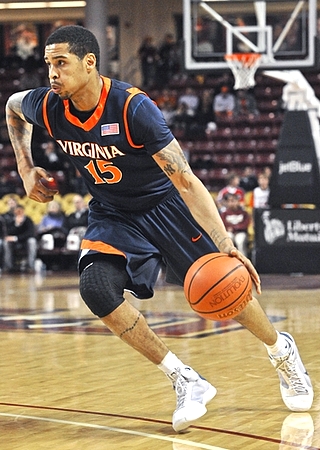
Jonathan Givony
After two seasons at Virginia, Sylven Landesbergs college basketball career appears to be over, as the school announced that hell be dropping out to pursue his professional aspirations. Landesberg was suspended before the ACC tournament for academic reasons, as he reportedly was not attending an art class he was enrolled in all semester long. Virginia finished the season 15-16 in its first year under Tony Bennett, after the coach that initially recruited Landesberg, Dave Leitao, was fired. It is presumed that Landesberg will now enter his name in the NBA draft, although no formal announcement has been made at this point.
Landesberg is coming off another very productive season at Virginiadespite playing in a completely different system than he was recruited to under Leitao--earning second-team All-ACC honors in the process. His scoring rate improved substantially this year (adjusting for pace and minutes played), although his efficiency numbers largely stagnated. His 2-point percentages (45%) remain unimpressive, although he is shooting the ball better from beyond the arc38%, up from 31% last year, on a limited number of attempts.
He continues to get to the free throw line, rebound, and distribute the ball effectively, while his turnover rate is down this season. From a statistical standpoint, hes obviously made strides this year, even if that didnt necessarily help his team that muchthey dropped 9 of their last 10 games and finished tied for second to last in the ACC, with a 5-11 record.
Using the data at our disposal to analyze the difference in Landesbergs role between this year and last, a couple of key things stand out. Most notable would be the pace his team played at, down from 68 possessions per game (92nd-fastest in the NCAA) to 63 (317th-fastest). Landesberg operated far less in transition according to Synergy Sports Technology, with jump-shots becoming a more important part of his game compared to last year. He was utilized substantially more coming off screens and in pick and roll plays this season, although he was allowed significant opportunities to operate in isolation situations as well.
Landesbergs main appeal as a prospect remains his ability to create his own shot as a 6-6 swingmansomething you just dont find that often. Hes an incredibly smooth, fluid athlete, not terribly explosive, but nevertheless possessing a wide array of shifty ball-handling skills and hesitation moves to get his man off balance and attack him with terrific timing. This is a skill that is extremely difficult to teach, and gives him a great base to build off as a scorer down the road. Watching him play, its not difficult to see a little bit of Evan Turner in his game in this regard, minus the same incredible versatility and feel for the game.
Unfortunately for Landesberg, he does not currently possess the same ability to finish his drives as he does creating then. He is not incredibly explosive around the basket, often lacking the verticality needed to get his shot off in traffic already at the college level, and not yet showing the best instincts for initiating contact in the paint and drawing fouls.
While he gets to the line at a solid rate (about average in fact amongst the NCAAs top shooting guard prospects), he could do a much better job of driving into his defenders (rather than around them) and not settling for as many floaters in the lane as he currently does.
Part of this will come naturally with added strength and experience, but getting coached up in this area and making more of a commitment to not settling for the first shot that becomes available will go a long ways in honing his terrific slashing potential.
As a shooter, Landesberg has clear-cut strengths and weaknesses. On one hand he doesnt get much elevation on his flat-footed and somewhat deliberate stroke, either in catch and shoot situations or when pulling up off the dribble. This will make it more difficult for him to get his shot off at the NBA level where defenders are bigger, longer and more athletic than in the NCAA.
On the other hand, Landesberg clearly has an innate feel and touch for making shots, something that again speaks to the talent he possesses. While he probably will need to tweak his mechanics and learn how to get his shot off quicker, he should be able to figure things out at some point in his career.
While Landesberg clearly projects as a swingman at the professional level, he does possess some very intriguing playmaking skills that demonstrate strong court vision and a high basketball IQ. He makes a couple of very nice passes each and every game, advancing the ball crisply in a simple and effective manner to get his teammates open looks, and sometimes threading the needle in highlight reel fashion for impressive assists. His ability to see the floor and help facilitate an offense will likely be appreciated more at the next level than it was at Virginia, as he simply does not have the quality of teammates around him to take fully show what he can do as a passer.
Landesbergs skill-set indicates that he would likely be better suited playing a complimentary role than acting as his teams main go-to guy. That really wasnt an option on a Virginia team that was in rebuilding mode when he arrived, though, something that became even more apparent in his second season after the school hired a new coach.
Defensively, Landesberg is average at best at the NCAA level and looks a good bit away from being able to hold his own on this end of the floor in the NBA. His fundamentals are poor, as hes very much prone to biting for fakes and gambling in the passing lanes, and is very quick to get out of his stance at the first opportunity possiblegetting beat quite a bit off the dribble in turn. Its not difficult to tell that this was not a big priority for him early on in his career. Possessing average length, strength and lateral quickness, Landesberg must commit himself to improving substantially on this end if he has his sights set on making an impact at the NBA level, especially early on in his career.
All things said, were clearly not looking at a finished product, and in a perfect world, Landesberg could have used another year of development before plunging head-first into the NBA draft. He is only 19 years old after all. He obviously was not all that interested in the academic side of being a college basketball player, thoughsomething that is clearly his rightand will now have to maneuver himself wisely to find the best situation to continue to develop his skill-set and attempt to reach his excellent potential.
Whether that means staying in the draft (where hes almost unanimously projected as, at best, a second round pick) or pulling his name out and spending time in the D-League or in Europe is anyones guess. Hes rumored to potentially be able to acquire an Israeli or Austrian passport sometime down the road, which would allow him to play as a non-American in leagues like Spain, Italy, Greece or Israel itself. It will be interesting to see which route Landesberg takes, and even if he doesnt make or stick around the NBA initially (by design or not)or even gets stashed for a few years by the team that drafts him-- hes an intriguing talent to keep track of to see how he continues to develop.
After two seasons at Virginia, Sylven Landesbergs college basketball career appears to be over, as the school announced that hell be dropping out to pursue his professional aspirations. Landesberg was suspended before the ACC tournament for academic reasons, as he reportedly was not attending an art class he was enrolled in all semester long. Virginia finished the season 15-16 in its first year under Tony Bennett, after the coach that initially recruited Landesberg, Dave Leitao, was fired. It is presumed that Landesberg will now enter his name in the NBA draft, although no formal announcement has been made at this point.
Landesberg is coming off another very productive season at Virginiadespite playing in a completely different system than he was recruited to under Leitao--earning second-team All-ACC honors in the process. His scoring rate improved substantially this year (adjusting for pace and minutes played), although his efficiency numbers largely stagnated. His 2-point percentages (45%) remain unimpressive, although he is shooting the ball better from beyond the arc38%, up from 31% last year, on a limited number of attempts.
He continues to get to the free throw line, rebound, and distribute the ball effectively, while his turnover rate is down this season. From a statistical standpoint, hes obviously made strides this year, even if that didnt necessarily help his team that muchthey dropped 9 of their last 10 games and finished tied for second to last in the ACC, with a 5-11 record.
Using the data at our disposal to analyze the difference in Landesbergs role between this year and last, a couple of key things stand out. Most notable would be the pace his team played at, down from 68 possessions per game (92nd-fastest in the NCAA) to 63 (317th-fastest). Landesberg operated far less in transition according to Synergy Sports Technology, with jump-shots becoming a more important part of his game compared to last year. He was utilized substantially more coming off screens and in pick and roll plays this season, although he was allowed significant opportunities to operate in isolation situations as well.
Landesbergs main appeal as a prospect remains his ability to create his own shot as a 6-6 swingmansomething you just dont find that often. Hes an incredibly smooth, fluid athlete, not terribly explosive, but nevertheless possessing a wide array of shifty ball-handling skills and hesitation moves to get his man off balance and attack him with terrific timing. This is a skill that is extremely difficult to teach, and gives him a great base to build off as a scorer down the road. Watching him play, its not difficult to see a little bit of Evan Turner in his game in this regard, minus the same incredible versatility and feel for the game.
Unfortunately for Landesberg, he does not currently possess the same ability to finish his drives as he does creating then. He is not incredibly explosive around the basket, often lacking the verticality needed to get his shot off in traffic already at the college level, and not yet showing the best instincts for initiating contact in the paint and drawing fouls.
While he gets to the line at a solid rate (about average in fact amongst the NCAAs top shooting guard prospects), he could do a much better job of driving into his defenders (rather than around them) and not settling for as many floaters in the lane as he currently does.
Part of this will come naturally with added strength and experience, but getting coached up in this area and making more of a commitment to not settling for the first shot that becomes available will go a long ways in honing his terrific slashing potential.
As a shooter, Landesberg has clear-cut strengths and weaknesses. On one hand he doesnt get much elevation on his flat-footed and somewhat deliberate stroke, either in catch and shoot situations or when pulling up off the dribble. This will make it more difficult for him to get his shot off at the NBA level where defenders are bigger, longer and more athletic than in the NCAA.
On the other hand, Landesberg clearly has an innate feel and touch for making shots, something that again speaks to the talent he possesses. While he probably will need to tweak his mechanics and learn how to get his shot off quicker, he should be able to figure things out at some point in his career.
While Landesberg clearly projects as a swingman at the professional level, he does possess some very intriguing playmaking skills that demonstrate strong court vision and a high basketball IQ. He makes a couple of very nice passes each and every game, advancing the ball crisply in a simple and effective manner to get his teammates open looks, and sometimes threading the needle in highlight reel fashion for impressive assists. His ability to see the floor and help facilitate an offense will likely be appreciated more at the next level than it was at Virginia, as he simply does not have the quality of teammates around him to take fully show what he can do as a passer.
Landesbergs skill-set indicates that he would likely be better suited playing a complimentary role than acting as his teams main go-to guy. That really wasnt an option on a Virginia team that was in rebuilding mode when he arrived, though, something that became even more apparent in his second season after the school hired a new coach.
Defensively, Landesberg is average at best at the NCAA level and looks a good bit away from being able to hold his own on this end of the floor in the NBA. His fundamentals are poor, as hes very much prone to biting for fakes and gambling in the passing lanes, and is very quick to get out of his stance at the first opportunity possiblegetting beat quite a bit off the dribble in turn. Its not difficult to tell that this was not a big priority for him early on in his career. Possessing average length, strength and lateral quickness, Landesberg must commit himself to improving substantially on this end if he has his sights set on making an impact at the NBA level, especially early on in his career.
All things said, were clearly not looking at a finished product, and in a perfect world, Landesberg could have used another year of development before plunging head-first into the NBA draft. He is only 19 years old after all. He obviously was not all that interested in the academic side of being a college basketball player, thoughsomething that is clearly his rightand will now have to maneuver himself wisely to find the best situation to continue to develop his skill-set and attempt to reach his excellent potential.
Whether that means staying in the draft (where hes almost unanimously projected as, at best, a second round pick) or pulling his name out and spending time in the D-League or in Europe is anyones guess. Hes rumored to potentially be able to acquire an Israeli or Austrian passport sometime down the road, which would allow him to play as a non-American in leagues like Spain, Italy, Greece or Israel itself. It will be interesting to see which route Landesberg takes, and even if he doesnt make or stick around the NBA initially (by design or not)or even gets stashed for a few years by the team that drafts him-- hes an intriguing talent to keep track of to see how he continues to develop.
Darington Hobson, 6-7, Junior, Small Forward/Power Forward, New Mexico, 15.9 points, 9.3 rebounds, 4.6 assists, 3.0 turnovers, 1.2 steals, 44.0% FG, 36.1% 3FG, 65.9% FT
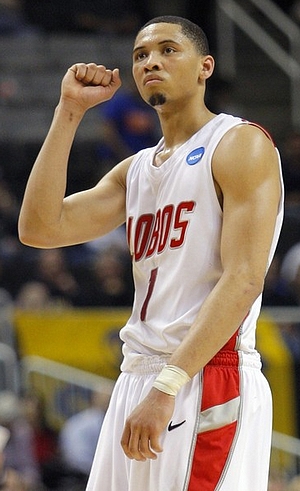
Kyle Nelson
When last wrote about Darington Hobson in January, we came away with significant question marks about how well his game would translate to the NBA level. Since January, Hobson has been named the Mountain West Conferences Player of the Year, carrying New Mexico to a top-10 national ranking, a three seed in the NCAA tournament, and a first round victory over Montana, before falling to Washington in the second round.
While Hobson has had a remarkable first season at New Mexico and is a legitimate NBA prospect going into the off-season, he has shown both his strengths and weaknesses against NBA-caliber athletes and has given scouts a better picture of his potential at the next level.
Hobson is still just an average athlete, particularly in terms of his explosiveness. He does, however, have good size for a small forward at the next level, standing 67 with a solid frame and length.
Hobson is able to somewhat compensate for his lack of ideal athleticism at the collegiate level with his scoring instincts, primarily his ability to get to the rim and initiate contact. Against bigger, more athletic defenders such as Quincy Pondexter and Kawhi Leonard, however, he struggled to create his own shot, and even though he still often drew contact, he was never much of a factor off the dribble against these types. Throughout this season, athletic defenders cut off his angles and reduced his options, which limited his effectiveness as a mid-range scorer. While his decision-making has been solid, his shaky shot selection does him no favors either, an issue represented by his mediocre 2-point percentages (46.5%).
He does show promise as a perimeter shooter, however, and he became more confident in his abilities as the season progressed. While he hit just 36.3% of his attempts from distance, his mechanics look good. He has a quick release, deep range and fairly consistent form when his feet are set.
This is not to say that hes an elite shooter, however, particularly when matched up against lengthy defenders. He attempted a limited amount of 3-pointers on the season and displayed troubling shot-selection at times, not quite knowing his limitations in this regard. His free throw shooting percentage sits at a mediocre 65% suggesting that he has some work to do in this area as well. How good of a shooter Hobson becomes will likely play a huge role in his ability to find a niche in the NBA down the road.
Perhaps the most interesting attribute Hobson brings to the table revolves around his court vision and all-around feel for the game. Hobson is a point-forward, facilitating all over the floor, from running the offense to passing out of the post. His passing ability is terrific and his ball handling abilities are very good for a player his size. He was however forced to shoulder a tremendous offensive load for New Mexico this season, exposing his inconsistent decision-making ability and rendering him somewhat turnover prone.
One of the most important challenges Hobson will face revolves around his ability transition into an effective role player at the next level, without garnering anywhere near as many possessions as he did in college. While his struggles this season can partially be attributed to the fact that he played at the junior college level for two years prior to stepping immediately into the role of primary scorer and facilitator at the collegiate level, there are legitimate concerns about his ability to fit in seamlessly on just any NBA roster. Hobson seems to need to have the ball in his hands to be successful, and not every coach will be willing to do that, especially if he struggles to create his own shot from the perimeter and cant shoot an acceptable percentage inside and outside the arc.
As a defender, Hobson hasnt changed much. He still tries and plays with intelligence, but his lack of ideal athleticism hurts him significantly. He struggles defending athletic wing players, and lacks the strength and size necessary to defending the NBA post.
Ultimately, Hobson will need to land on the right team and on the right system to maximize his very intriguing strengths. While looking for comparable players at the next level, names like Luke Walton and Jared Dudley come to mind. Dudley is a much better shooter than Hobson is at this stage, and both players were able to show that they can perform in secondary roles at the collegiate level, but there are distinct parallels to be drawn.
All indications suggest that Hobson will enter and keep his name in the NBA Draft this spring, and his stock appears to fluctuate wildly depending on who youre talking to. Private workouts may end up playing a huge role in where he ends up being picked, as NBA teams will want to see how he fares against comparable athletes when trying to project him to the NBA.
When last wrote about Darington Hobson in January, we came away with significant question marks about how well his game would translate to the NBA level. Since January, Hobson has been named the Mountain West Conferences Player of the Year, carrying New Mexico to a top-10 national ranking, a three seed in the NCAA tournament, and a first round victory over Montana, before falling to Washington in the second round.
While Hobson has had a remarkable first season at New Mexico and is a legitimate NBA prospect going into the off-season, he has shown both his strengths and weaknesses against NBA-caliber athletes and has given scouts a better picture of his potential at the next level.
Hobson is still just an average athlete, particularly in terms of his explosiveness. He does, however, have good size for a small forward at the next level, standing 67 with a solid frame and length.
Hobson is able to somewhat compensate for his lack of ideal athleticism at the collegiate level with his scoring instincts, primarily his ability to get to the rim and initiate contact. Against bigger, more athletic defenders such as Quincy Pondexter and Kawhi Leonard, however, he struggled to create his own shot, and even though he still often drew contact, he was never much of a factor off the dribble against these types. Throughout this season, athletic defenders cut off his angles and reduced his options, which limited his effectiveness as a mid-range scorer. While his decision-making has been solid, his shaky shot selection does him no favors either, an issue represented by his mediocre 2-point percentages (46.5%).
He does show promise as a perimeter shooter, however, and he became more confident in his abilities as the season progressed. While he hit just 36.3% of his attempts from distance, his mechanics look good. He has a quick release, deep range and fairly consistent form when his feet are set.
This is not to say that hes an elite shooter, however, particularly when matched up against lengthy defenders. He attempted a limited amount of 3-pointers on the season and displayed troubling shot-selection at times, not quite knowing his limitations in this regard. His free throw shooting percentage sits at a mediocre 65% suggesting that he has some work to do in this area as well. How good of a shooter Hobson becomes will likely play a huge role in his ability to find a niche in the NBA down the road.
Perhaps the most interesting attribute Hobson brings to the table revolves around his court vision and all-around feel for the game. Hobson is a point-forward, facilitating all over the floor, from running the offense to passing out of the post. His passing ability is terrific and his ball handling abilities are very good for a player his size. He was however forced to shoulder a tremendous offensive load for New Mexico this season, exposing his inconsistent decision-making ability and rendering him somewhat turnover prone.
One of the most important challenges Hobson will face revolves around his ability transition into an effective role player at the next level, without garnering anywhere near as many possessions as he did in college. While his struggles this season can partially be attributed to the fact that he played at the junior college level for two years prior to stepping immediately into the role of primary scorer and facilitator at the collegiate level, there are legitimate concerns about his ability to fit in seamlessly on just any NBA roster. Hobson seems to need to have the ball in his hands to be successful, and not every coach will be willing to do that, especially if he struggles to create his own shot from the perimeter and cant shoot an acceptable percentage inside and outside the arc.
As a defender, Hobson hasnt changed much. He still tries and plays with intelligence, but his lack of ideal athleticism hurts him significantly. He struggles defending athletic wing players, and lacks the strength and size necessary to defending the NBA post.
Ultimately, Hobson will need to land on the right team and on the right system to maximize his very intriguing strengths. While looking for comparable players at the next level, names like Luke Walton and Jared Dudley come to mind. Dudley is a much better shooter than Hobson is at this stage, and both players were able to show that they can perform in secondary roles at the collegiate level, but there are distinct parallels to be drawn.
All indications suggest that Hobson will enter and keep his name in the NBA Draft this spring, and his stock appears to fluctuate wildly depending on who youre talking to. Private workouts may end up playing a huge role in where he ends up being picked, as NBA teams will want to see how he fares against comparable athletes when trying to project him to the NBA.
Jimmer Fredette, 6-2, Junior, Point Guard, BYU
20.7 Points, 3.2 Rebounds, 4.7 Assists, 2.6 Turnovers, 1.2 Steals, 47% FG, 48% 3FG, 88% FT
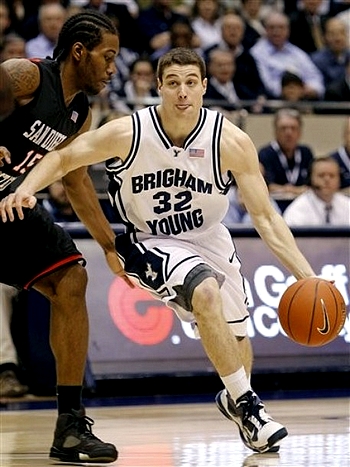
Matthew Williams
One of most pleasant surprises in college basketball this season, Jimmer Fredette was nothing short of spectacular all season long. Though he couldnt save the Cougars against Kansas State last week, no one can question his ability to put his team on his back and carry them to victories. With his season coming to a close, Fredette now faces his impending draft decision.
A controversial prospect, Fredette has one of the most impressive offensive packages in college basketball, but may lack the athleticism needed to translate his skill-set seamlessly to the next level. Throughout the season, and especially during MWC play, Fredette was able to consistently and efficiently compensate for his lack of elite explosiveness and leaping ability with excellent body control, a great understanding of how to subtly change speeds and directions to lull his defender to sleep, and a crafty array of shots around the basket.
To a much greater extent than the average slow-footed, undersized scorer, Fredette is comfortable in his own skin. A quarter of his offense was comprised of one-on-one situations according to Synergy Sports Technology, and he finishes at a near-50% clip at the rim a testament to his ability to overcome his weaknesses. Exceptionally good at not only finding creases to beat his own man, Fredette does a great job reading help side defenders and attacking his man in a way that shields him from weak-side roations. Whether he can make a comparable impact at the next level is something that teams will likely want to study in private workouts against more physically gifted guard prospects.
Posessing a strong frame and the ability to surprise defenders with his agility and balance when changing directions in the lane, Fredettes athleticism isnt as much of a concern on the offensive end as it is defensively. With no shortage of toughness or aggressiveness, Fredette plays a sound brand of defense, but his limited physical tools hurt him considerably and would likely make him a significant target to isolate against on the perimeter at the NBA level.
Appearing a step slow closing out, not possessing the size and length to bother shooters or be a factor in the passing lanes, and lacking any real lateral quickness, Fredette was able to get by in BYUs zone and play effective man defense on occasion. However, with the NBA handcheck rules neutralizing whatever strength advantage he could potentially try and use over his matchups on the next level, he projects as a defensive liability at the next level, any way you slice it. Should he keep his name in this draft, his ability to defend is likely the facet of his game that teams will attempt to evaluate most thoroughly in private settings.
Though there are aspects of his game that remain question marks from an NBA perspective, there are others that have talent-evaluators enamored with his game. Fredette has improved his jump shooting ability markedly since his freshman year, and now sits as one of the best shooters in our database. A tremendous catch and shoot threat who has also improved his ability to hit shots off the dribble, Fredette can certainly help a team on any level with his ability to stretch the floor. His efficiency from the line is a bonus as well, as hes a valuable asset in late game situations.
Aside from his merits as a shooter, Fredette has improved his efficiency as a passer as well. Though his usage has risen markedly from last season, Fredettes assist to turnover ratio has grown from 1.59 last season to 1.84 this season. Given his tremendous basketball IQ, it will be interesting to see how Fredette responds to a diminished role on the next level. Hes a solid passer, but his ability to set his teammates up and play low-mistake basketball will only help his cause as he carves out a niche for himself early in his career.
Considering what hes accomplished this season and the struggles he will face in terms of improving upon his weaknesses, Fredette faces a difficult decision on whether to leave his name in the upcoming draft. Its difficult to see how much better of a year he could have (even though he was diagnosed with mononucleosis midway through the season), and hes unlikely to get significantly more athletic over the offseason. With a lot to gain from performing well in private workouts in a weak year for point guardsbut very limited amount of time to actually test the waters due to new rules the NCAA implemented-- Fredette is a name to keep an eye on in the draft process.
One of most pleasant surprises in college basketball this season, Jimmer Fredette was nothing short of spectacular all season long. Though he couldnt save the Cougars against Kansas State last week, no one can question his ability to put his team on his back and carry them to victories. With his season coming to a close, Fredette now faces his impending draft decision.
A controversial prospect, Fredette has one of the most impressive offensive packages in college basketball, but may lack the athleticism needed to translate his skill-set seamlessly to the next level. Throughout the season, and especially during MWC play, Fredette was able to consistently and efficiently compensate for his lack of elite explosiveness and leaping ability with excellent body control, a great understanding of how to subtly change speeds and directions to lull his defender to sleep, and a crafty array of shots around the basket.
To a much greater extent than the average slow-footed, undersized scorer, Fredette is comfortable in his own skin. A quarter of his offense was comprised of one-on-one situations according to Synergy Sports Technology, and he finishes at a near-50% clip at the rim a testament to his ability to overcome his weaknesses. Exceptionally good at not only finding creases to beat his own man, Fredette does a great job reading help side defenders and attacking his man in a way that shields him from weak-side roations. Whether he can make a comparable impact at the next level is something that teams will likely want to study in private workouts against more physically gifted guard prospects.
Posessing a strong frame and the ability to surprise defenders with his agility and balance when changing directions in the lane, Fredettes athleticism isnt as much of a concern on the offensive end as it is defensively. With no shortage of toughness or aggressiveness, Fredette plays a sound brand of defense, but his limited physical tools hurt him considerably and would likely make him a significant target to isolate against on the perimeter at the NBA level.
Appearing a step slow closing out, not possessing the size and length to bother shooters or be a factor in the passing lanes, and lacking any real lateral quickness, Fredette was able to get by in BYUs zone and play effective man defense on occasion. However, with the NBA handcheck rules neutralizing whatever strength advantage he could potentially try and use over his matchups on the next level, he projects as a defensive liability at the next level, any way you slice it. Should he keep his name in this draft, his ability to defend is likely the facet of his game that teams will attempt to evaluate most thoroughly in private settings.
Though there are aspects of his game that remain question marks from an NBA perspective, there are others that have talent-evaluators enamored with his game. Fredette has improved his jump shooting ability markedly since his freshman year, and now sits as one of the best shooters in our database. A tremendous catch and shoot threat who has also improved his ability to hit shots off the dribble, Fredette can certainly help a team on any level with his ability to stretch the floor. His efficiency from the line is a bonus as well, as hes a valuable asset in late game situations.
Aside from his merits as a shooter, Fredette has improved his efficiency as a passer as well. Though his usage has risen markedly from last season, Fredettes assist to turnover ratio has grown from 1.59 last season to 1.84 this season. Given his tremendous basketball IQ, it will be interesting to see how Fredette responds to a diminished role on the next level. Hes a solid passer, but his ability to set his teammates up and play low-mistake basketball will only help his cause as he carves out a niche for himself early in his career.
Considering what hes accomplished this season and the struggles he will face in terms of improving upon his weaknesses, Fredette faces a difficult decision on whether to leave his name in the upcoming draft. Its difficult to see how much better of a year he could have (even though he was diagnosed with mononucleosis midway through the season), and hes unlikely to get significantly more athletic over the offseason. With a lot to gain from performing well in private workouts in a weak year for point guardsbut very limited amount of time to actually test the waters due to new rules the NCAA implemented-- Fredette is a name to keep an eye on in the draft process.















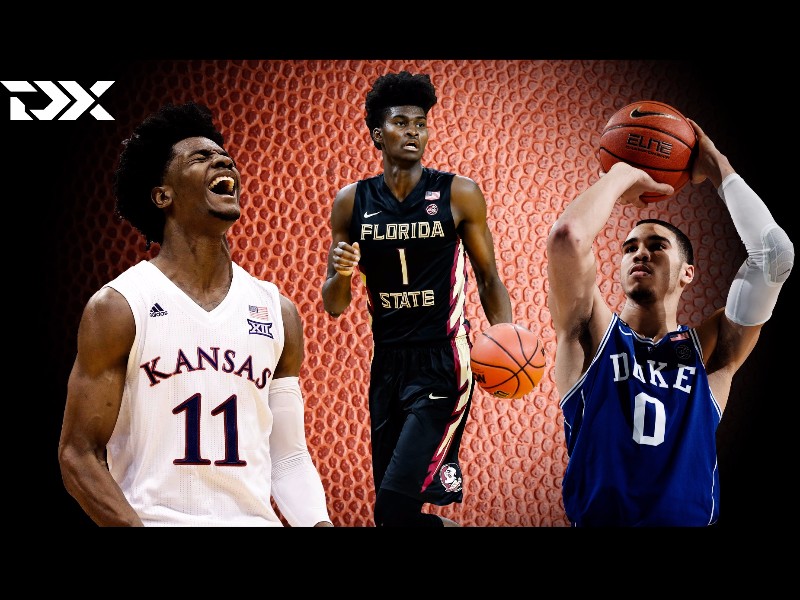
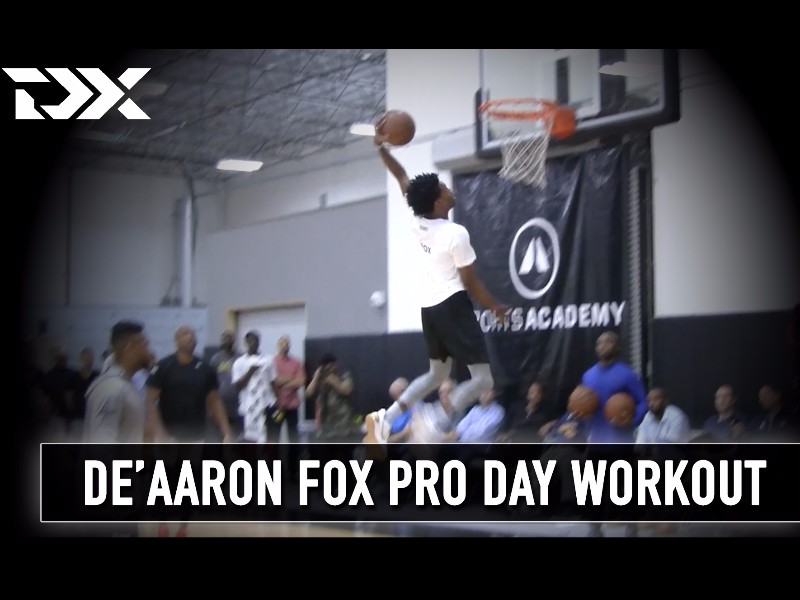




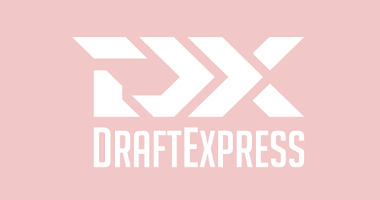















Comments